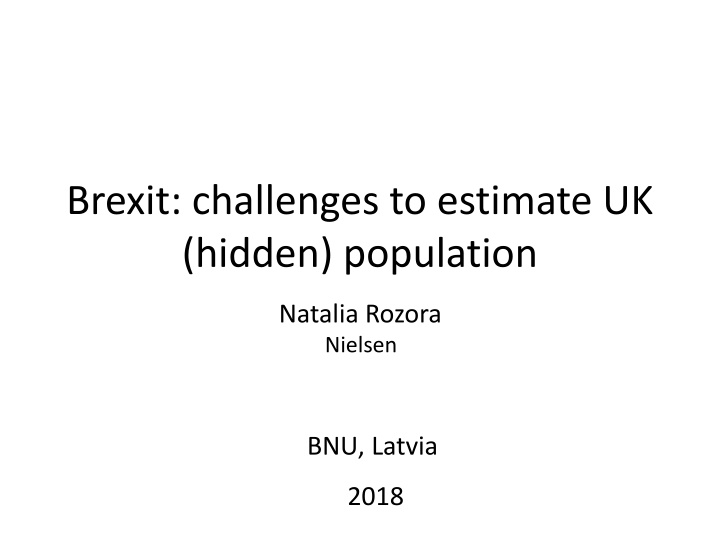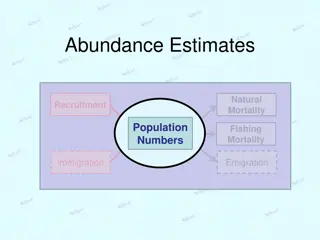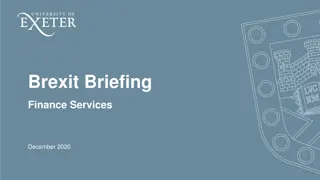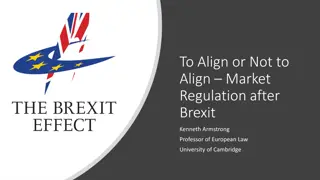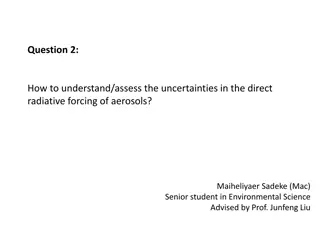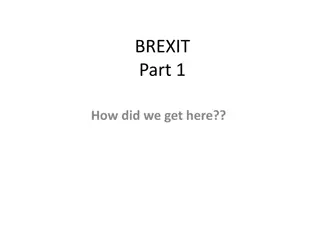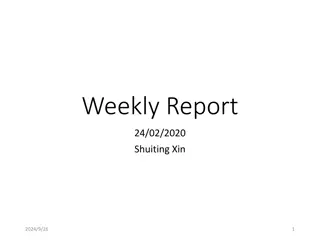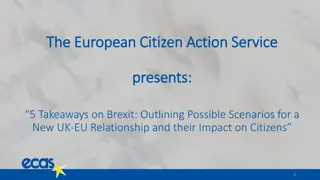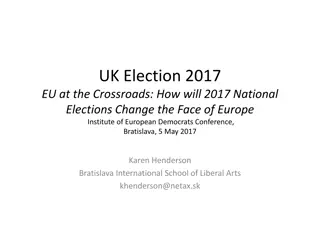Challenges in Estimating UK Population Amid Brexit Uncertainties
The impact of Brexit on estimating the UK population poses significant challenges due to hidden factors, changes in migration patterns, and uncertainties surrounding the transition. Various scenarios, approaches, and data sources are explored to address this complex issue.
Download Presentation

Please find below an Image/Link to download the presentation.
The content on the website is provided AS IS for your information and personal use only. It may not be sold, licensed, or shared on other websites without obtaining consent from the author.If you encounter any issues during the download, it is possible that the publisher has removed the file from their server.
You are allowed to download the files provided on this website for personal or commercial use, subject to the condition that they are used lawfully. All files are the property of their respective owners.
The content on the website is provided AS IS for your information and personal use only. It may not be sold, licensed, or shared on other websites without obtaining consent from the author.
E N D
Presentation Transcript
Brexit: challenges to estimate UK (hidden) population Natalia Rozora Nielsen BNU, Latvia 2018
Agenda Brexit : possible scenarios Challenges Possible data sources Possible approaches for population estimation
Brexit Timelines 31 October, 2018 31 December, 2020 The transition period is due to end. 23 June, 2016 Negotiations must be complete The referendum 19 March, 2018 29 March, 2019 Brexit day. Transition plan released Uncertainty of any sort results in volatility and Brexit will be no exception
Google trends for Brexit Top "how will Brexit affect...?" 1 Euro 2 Pound 3 House prices 4 Immigration 5 Stock market
Possible scenarios of Brexit Open Soft Brexit staying as closely aligned to the EU as possible. Single market or the customs union or both. free movement of people, allowing European Union citizens rights to settle in the UK with access to public services and benefits. Norway model freedom of movement of people, make a contribution to the EU budget and abide by the rulings of the European Court of Justice, in exchange for remaining in the single market. Single Market / Custom Union, Canada model Refers to a free-trade agreement which removes lots of barriers to trade between the two, but not as many as the Norway model Customs partnership hybrid model, would enable trade in goods without the need for customs checks. Low High Hard Brexit A hard Brexit would be one where few of the existing ties between the UK and the EU were retained Closed Freedom of movement of people
Challenges Changes in Migration . Homelessness .. Hidden population
Methodology for population estimation in UK Cohort component methods Following data sources are used: Births Deaths UK Armed Forces US Armed Forces Patient Register (PR) Higher Education Statistics Agency (HESA) Prisoners National Health Service Central Register (NHSCR) Migrant Workers Scan (MWS) Asylum Seeker Data and Non- Asylum Enforced Removals Home Office Immigration Asylum Seekers Support
UK population 2017 Estimates of the resident population of the UK by country of birth and nationality, 2016 Country of birth Nationality Estimate Percentage Estimate Percentage All residents 64,727 100 64,727 100 UK born/British National 55,554 86 58,710 91 Non-UK born/Non-British National 9,152 14 5,998 9 EU27 3,537 5 3,572 6 EU14 1,596 2 1,563 2 EU8 1,443 2 1,569 2 EU2 395 1 413 1 Non-EU 5,616 9 2,425 4 Asia 2,923 5 1,269 2 Rest of the World 2,353 4 988 2 Source: Annual Population Survey (APS), Office for National Statistics
Non-UK born residents Trends Estimates of the non-UK born resident population of the UK by country of birth, 2004 to 2016 (ths) 10000 9000 8000 7000 6000 5000 4000 3000 2000 1000 0 2004 2005 2006 2007 2008 2009 2010 2011 2012 2013 2014 2015 2016 EU14 EU8 EU2 Asia Rest of the World Source: Office for National Statistics
Who are homelessness? People sleeping rough. Single homeless people living in hostels, shelters and temporary supported accommodation. Statutorily homeless households that is, households who seek housing assistance from local authorities on grounds of being currently or imminently without accommodation. Hidden homeless households that is, people who may be considered homeless but whose situation is not visible either on the streets or in official statistics. Examples are shared / overcrowded Available statistics is limited: 9ths people are sleeping rough in London snapshot and it is >200% over decade (GLA/CHAIN Street to Home monitoring ) . Nationality-wise : 54% -UK, 27% - CEE, 19% -other ~50 ths people are single homeless or Statutorily homeless households (DCLG statutory homelessness statistics) 7% are overcrowded tenures and it is growth by 2pp over decade (Survey of English Housing/English Housing Survey)
Hidden population in scenarios Same Open Soft Brexit . Norway model Single Market / Custom Union, Canada model Customs partnership Low High Hard Brexit Closed High Freedom of movement of people
Problem statement How to measure hidden population with expectation of change in trends?
Consideration for solution Census-like enumeration is not used for hidden population estimation? sample frame is not available Network-based approaches: Snowball sampling (case for Hungary homelessness estimation). The network scale-up method. It based on defining social networks of target population (It is identified their personal network size of sampled ones and based on proportion of members belonging to target population, the target population is defined) Other?
Network-based approach: sampling technique Sample selection approach : respondent- driven sampling (RDS) Recruitment process can be through reference ( coupon service proposal)
Further consideration RDS is practical and easier in implementation to collect minimum list of target population Method defining for target population size estimation (currently it is ideation)
